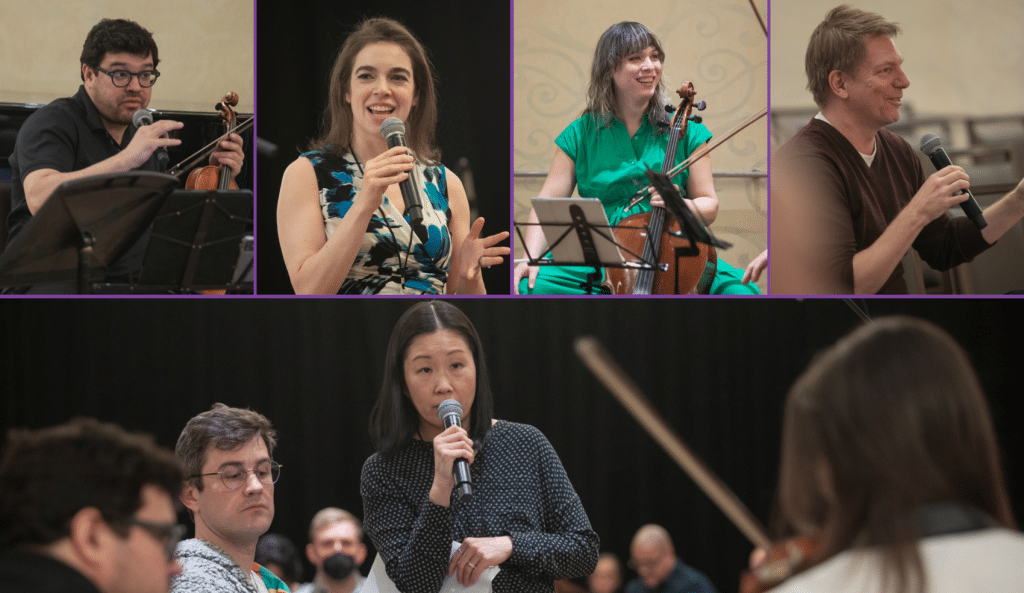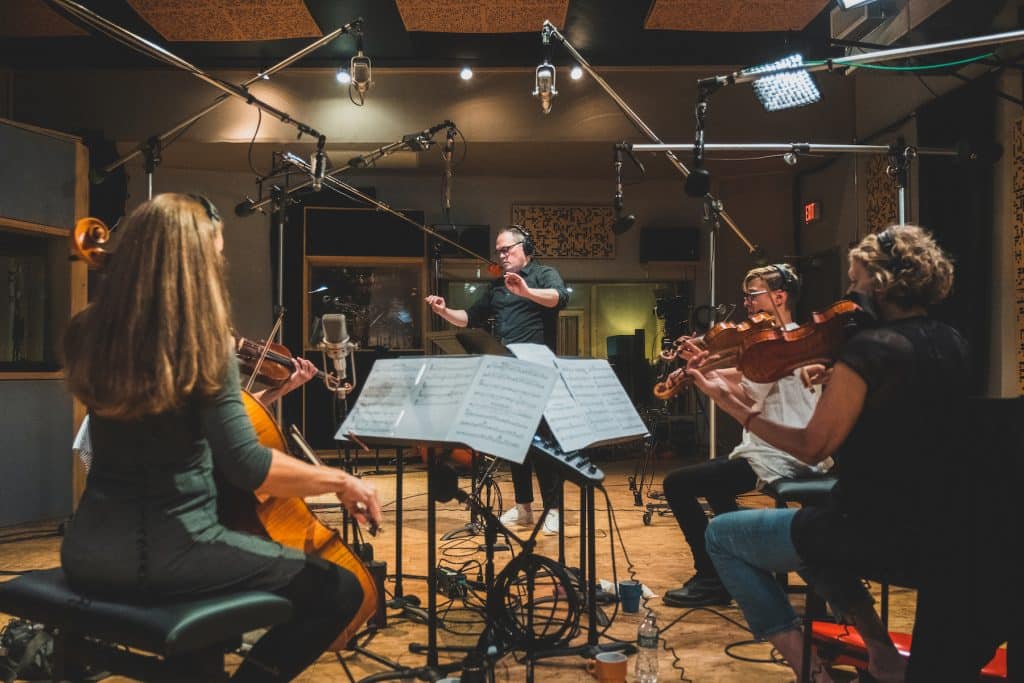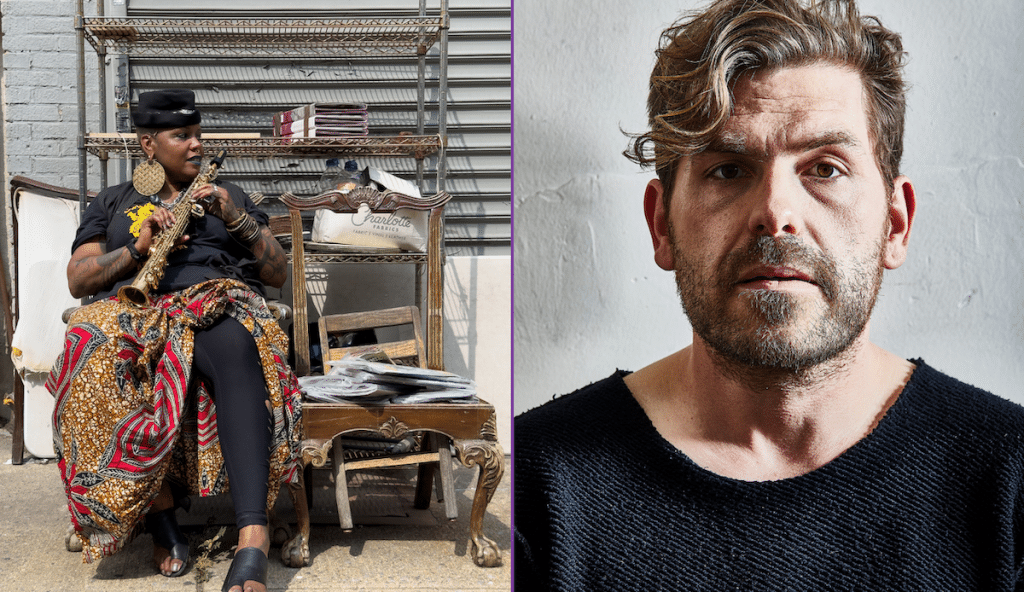Off the Page
Concept Lab opens up the process of creating new musical works, and reframes the often-solitary work of the composer.
The Attacca Quartet workshops new works by composers Asuka Kakitani (bottom); Liza Sobel Crane (top, second from left); and Will Stackpole (top, far right) at the CMA National Conference.
Photos by Becky Yee Photography

By the yellow light of a hotel ballroom chandelier, in a mid-morning session on the second day of Chamber Music America’s annual conference, Attacca Quartet—two-time Grammy Award winner, with repertoire ranging from the string quartet’s roots to its latest frontiers—is sightreading Will Stackpole’s Halation Sketches. When the musicians reach page twelve, their forward motion, graceful thus far, grinds to a confused halt.
At that point in the score, three new staves suddenly join the customary four-voice layout. At first glance, these pitchless parts look like they could be auxiliary percussion but, rather than rhythmic noteheads, single dotted lines extend from neutral-cleffed staves. The lines slope up and down to indicate what seems like relative pitch, their steepness fluctuating to mark change over time.
“What are those?” asks violist Nathan Schram, using his bow to point at the mystery clefs on his iPad screen.
“That’s where you detune,” Stackpole says, cheerily. The dotted lines, the composer explains, will guide the tension of the musicians’ strings as they pluck coarsely behind the bridge.
“Oh no,” says Schram reflexively—and perhaps a bit too emphatically, he realizes, when the audience erupts into laughter.
Here, the Attaccas served as test subjects for a special CMA conference iteration of Concept Lab, a unique model of composer readings created by the Chicago organization Access Contemporary Music (ACM) and its executive director, the composer Seth Boustead. Rather than focusing on pieces at or near their final drafts, Concept Lab stipulates that composers bring in-progress works to hone in front of audiences, providing a plain view of a process that so often happens behind closed doors. It’s a rare opportunity to workshop granular ideas with real-time reactions, questions, and feedback—and without the onus of a crisp, clean product.
Concept Lab revolves around its orientation as an early step in the compositional timeline, said Boustead.
In the traditional commissioning model, the dialogue between composer and performer often only flows one way— the composer is generally expected to show up to the first rehearsal with a final score, subject only to minor adjustments. “Traditionally, the musicians act as a mouthpiece for the ‘genius’ composer’s work,” Boustead said. “Concept Lab throws that idea on its head: we want the composer to take this feedback and use it in a way that’s musically productive.”
The three composer participants at CMA’s iteration of the Lab—Stackpole, Liza Sobel Crane, and Asuka Kakitani— agreed that producing a “work-in-progress” fit for public eyes required a radical shift of mindset. “It’s easy to write frenetically for three weeks and end up with a finished piece,” said Stackpole. In several cases, the sketches presented at the workshop would turn out to be the final product; at the time, none of the three pieces-in-progress had planned premieres, though the Boulanger Initiative (which co-presented the confer- ence session) would grant a commission to at least one of the participants.
Theoretically, a work can be “in progress” at any point between start and finish. The three participants’ radically different approaches to their sketches (and their time spent with the quartet) were a testament to the many possible routes a composition can travel from blank page to complete composition. With her OWLS / TREES, Asuka Kakitani focused on a sense of narrative, mapping moments of the piece to the quotidian life of a barn owl. With flurries of harmonics, her score notes explained, the owl spread its wings; with rippling sixteenth notes, it took flight; and with grotesque bow whaps, it stopped to feast on a hapless bit of prey.
The questions that Kakitani spread around her score mostly focused on what and which. Should the tempo stay consistent through this transition, or change? Should the bow taps be Col legno battuto (where the wood of the bow bounces off the string) or crini battuto (where the hair pads the wiry wooden clicks)? For Kakitani, a pianist and composer originally trained in jazz, the string quartet was relatively new territory; experimenting with novel sounds and textures without pressure to decide yet was a welcome luxury, she said. She only wished the audience had gotten to add its own feedback to the mix. Boustead mentioned that audiences can do so at ACM’s quarterly Concept Lab readings in Chicago—a piece for piano and amplified cactus recently caused a stir there—but at the conference, limited time kept the spectators’ input to a simple yes-or-no nod.
Liza Sobel Crane, a Chicago-based composer, didn’t embed explicit questions in her unnamed sketches. Still, similar questions of “what” and “which” bubbled up. Rather than filling her scores with question marks, each excerpt came in several numbered iterations, almost like one would find on a film-set clapboard for various “takes.” The differences ranged from small variations in inflection and bow placement to larger questions of vertical interplay between parts—and by the end of Crane’s half-hour, Attacca had begun to weave her versions together, significantly widening the possibilities.
Crane was the only Concept Lab participant with prior experience work- shopping unfinished works, by way of Gabriela Lena Frank’s Creative Academy of Music. Frank encourages her students to examine their own compositional processes much in the same way that Crane approached her Concept Lab sketches: a minute or two of music, written in several discrete ways, to be finished several months later. She was open and excited at the possibility of Attacca combining her different concepts: “You might only like one of them, or you might like all of them,” said Crane. “It doesn’t have to be an either-or.”
If Kakitani and Crane centered their experimentation around questions of “what” and “which,” Will Stackpole’s Halation Sketches dove headlong into “if.” He built an entire world around his fragments, laying out a complex, bespoke notational index of noises, both instru- mental and vocal. Some of them were easy enough to execute—plucked thuds from behind the bridge, sharp breaths in and out. Others seemed forbiddingly difficult, though Attacca breezed right through them: Even while singing and playing simultaneously, their correct-note count was dizzyingly high.
Stackpole ran into more logistical bumps than either of his colleagues during his half-hour with Attacca. Though he was relieved to learn (from collective nods when he asked) that the audience could hear the quartet’s fingernails scratching on the thread at the tips of their strings, cellist Andrew Yee noted that after a few minutes of clawing, her thread was all but shredded. It wasn’t a huge deal, she assured him, though the bare steel string beneath the wound thread changed the sound drastically.
And then, that detuning incident, courtesy of the score’s twelfth page. By the end, even Attacca’s perplexed violist agreed that the effect was singularly cool. Yet the score provided no time to ensure the instruments returned to their usual pitch for the following section; fix that, the violist said, and he’d quit complaining.
It’s no secret that concept lab is a rare opportunity for its participants, but it also lends unprecedented insights to its spectators. When an audience hears a newly commissioned piece, it’s a final version that’s been edited for days, even weeks. Concept Lab sketches come too early in the compositional process for that manicured perfection; the audience gets a plain view at the trial-and-error that so often happens in hypotheticals. Especially in the case of works meant for reading sessions—where the end goal is often a usable recording for applications to grants, jobs, or competitions—live instruments don’t typically play the piece at any point during this typically solitary process. Composers have to make assumptions about what does and doesn’t work based on knowledge from textbooks and prior experience, rather than direct feedback.
Above all else, Concept Lab places composers in a vulnerable spot: In a way, all three participants bared their souls in that Times Square Westin ballroom on that frigid January Friday. Presenting sketches of a composition is almost like presenting an outline of an essay: it’s a clear, streamlined view into the way one’s brain intuits the creation process. Many like to keep those early stages behind closed doors, obsessing in private before letting any audience near their work.
In a way, that feeds into the historical mystique of the “genius composer.”
Boustead says that lifting the shroud of mystery is tough, but ultimately rewarding. Composers have to obsess over their final products—after all, that’s the performer’s bare starting point. But when a composer re-contextualizes their goal away from the finished work, Boustead says, it takes some of the pressure off. Rather than the performers serving as mouthpieces for the “genius,” the constructive dialogue flows freely in both directions, allowing for experimentation that’s often more productive.
“Maybe composers are geniuses. Maybe they’re not. What’s more fun is to play, to have fun, to try out new ideas,” said Boustead. “Composers always worry about whether they wrote a masterpiece. Who cares?!”



